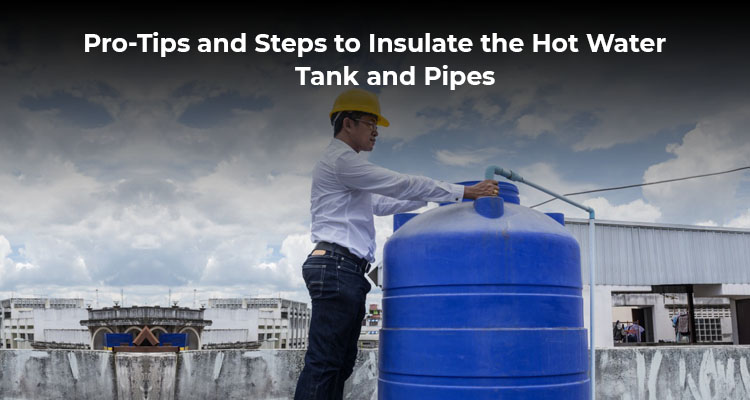Pro-Tips and Steps to Insulate the Hot Water Tank and Pipes

“Want to keep your electric water tanks safe? Let’s find out how wrapping a water tank insulation jacket helps you save your bills and water heaters.” A water tank thermal insulation jacket improves the energy efficiency of water and also keeps the temperature optimum.
Introduction:
Covering the appliance and other electronic items increase their life. Therefore, we always try to cover and protect them in many ways. Proper maintenance, quarterly cleaning of parts, and many other activities are performed to keep the gadgets and daily use electronics secure. Out of all these items, we hot water tanks or geysers are the delicate items that need higher maintenance and attention as their task is to outlet the hot water. The hot water may cause damage to the tank and water pipers.
How do you keep the water tanks secure? A simple solution is insulation. Insulating hot water tanks and pipes will degrade the quantity of heat they lose, keeping them more efficient.
What is Insulation?
An insulation blanket is a multi-layered cover that is wrapped around the hot water heater and controls the heat loss. The water tank insulation activity also maintains the water temperature in the water tank.
The water tank thermal insulation material is made up of many heat resistant materials, such as foil, fiberglass, etc. The padding and layering of water depend upon the heater.
How to Find Which Water Tank Thermal Insulation Jacket is Best For My Heater?
Always check the R-value of the tank. This number indicated the heat resistance of your tank/heater. If the R-value is below 24, then you should insulate it (it isn’t warm). If the R-value is higher than 24, then you need other types of insulation accordingly. The higher R-value provides more insulation to your water tank.
Steps to Follow for Water Tank Thermal Insulation
The insulation is done according to the layers. The foam or any insulation material has some thickness and density. These factors depend on the R-value which denotes the capability of thermal resistance. Insulating the water tanks/heaters is not that difficult what we think. Here are a few simple steps to follow for perfect water tank thermal insulation.
- Turn the water heater off and wait for it to cool down
- Check the R-value number on the heater and get the insulation sheet accordingly. Any insulation material provider will give you the sheet according to the R-value.
- Clear the space around the heater and clean it properly.
- Measure the dimension with the tape and cut the insulating sheet.
- Wrap it up around your heater and there you go!
DOs and DON’Ts:
- Switch off and unplug the heater before you start the insulation process.
- Always clean the heater before use.
- Don’t cover the important label or sticker of the heater tank.
- Leave a gap for controls
- Write the note on a water tank insulation jacket if there’s any important information labeled at the tank.
- Leave some space for LEDs and other signals in the heater.
Water tank insulation covers are made with fine and tested materials which makes it more reliable and can be used for long run.
There were the covering tips to insulate your water heaters and prevent heat loss. Well, the tanks are safe now. But what about the water piper from which the hot water goes out? Do ordinary water pipes work efficiently when hot water passes through them? Is there any heat loss?
Can We Insulate Hot Water Pipes?
Yes, Of course, you can insulate your water pipes as well. It is more important to cover the pipe as they carry the hot water from the tank. Let’s find out a few tips that help out to insulate water pipes.
Steps to Insulate Pipes:
- Measure the lengths required dimensions required for insulation.
- Use sharp tools to cut the pipe sleeves according to the dimensions.
- Place the insulation pieces along the pipe with the face down.
- Use cable ties or tape to cover the pipe.
DO and DON’Ts:
- Make sure you insulate at least the first 3 feet pipe from the tank as these are crucial stages of water flow.
- Start the insulation process right start form the water tank nozzle.
- Do not overwrap the pipe. Make sure it is wrapped equally.
- Always wear gloves, long sleeves apparel if you are using fiberglass pipe wrap.
- For has heaters, use fiberglass pipe and for electric water heater, foam pipe can be used. Foam pipes such as neoprene, polyethylene, etc. are used for electric heater tanks.
More Ways to Save Energy and Reduce Bills
Insulation is a great way to save your bills and energy as well. These little measures cost less and give you a huge benefit. Here are a few more points to keep your pocket green.
- Insulate your home: Keep your home insulated so that your house’s temperature stays constant during all seasons
- Insulate your water tanks: Insulating water tanks keep water temperature constant and protect water from other contamination.
- Hot water cylinder service
- Bleed the radiators
- Arrange a home energy audit
Conclusion
These were the easiest and common steps to insulate your water tank heater and pipes. Insulation not only increases the life of water heaters but also reduces the bills. Control the heat loss by insulating your water tanks and pipe today. There are several types of insulation materials available in the market, make sure you choose the right one for you.

